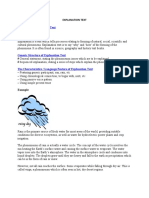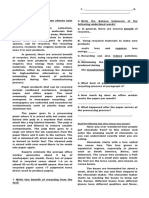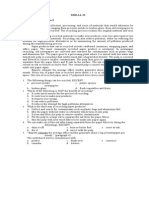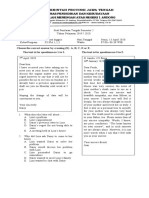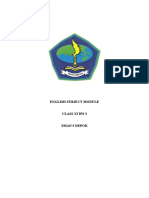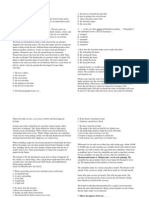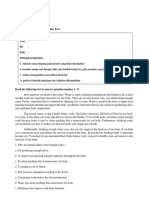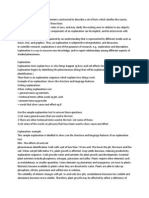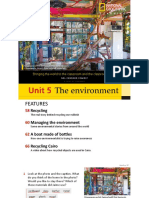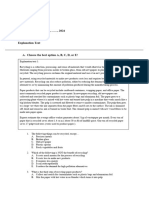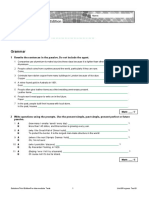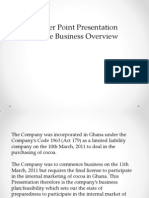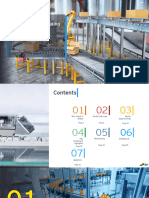EXPLANATION TEXT
To tell processes relating to forming of natural, social, scientific, and cultural phenomena.
To explain how or why something happens.
Generic Structure
General statement : stating the phenomenon issues which are to be explained.
Sequenced explanation : stating a series of steps which explain the phenomena.
Present tense – V1 (is, are, produce, contain, make, etc)
Passive Voice – be + V3 (is made, are shipped, are blended, ets)
Action verb (ground, grow, make, etc)
How Chocolate Is Made
Have we wondered how we get chocolate from? Well this
time we will enter the amazing world of chocolate so we
can understand exactly we are eating.
Chocolate starts a tree called cacao tree. This tree grows in
equatorial regions, especially in place such as South
America, Africa, and Indonesia. The cacao tree produces a
fruit about the size of a small pine apple. In side the fruits
are the tree’s seeds. They are also known as coco beans.
Next, the beans are fermented for about a week, dried in the sun. After that they are
shipped to the chocolate maker. The chocolate maker starts processing by roasting the
beans to bring out the flavour. Different beans from different places have different
qualities and flavour. So they are often shorted and blended to produce a distinctive
mix.
The next process is winnowing. The roasted beans are winnowed to remove the meat
nib of the cacao bean from its shell. Then the nibs are blended. The blended nibs are
grounded to make it liquid. The liquid is called chocolate liquor. It tastes bitter.
All seeds contain some amount of fat and cacao beans are not different. However,
cacao beans are half fat, which is why they ground nibs from liquid. It is pure bitter
chocolate.
Active Sentences
Subjects Verb Object / Complements
Passive Sentences
Subjects Verb Object / Complements
Text 1
Recycling is a collection, processing, and reuse of materials that would otherwise be 1.______ away. Materials ranging from precious metals to broken
glass, from old newspapers to plastic spoons, can be recycled. The recycling process reclaims the original material and uses it in new products.
�In general, using recycled materials to make new products costs less and requires less energy than using new materials. Recycling can also 2._____
pollution, either by reducing the demand for high-pollution alternatives or by minimizing the amount of pollution produced during the manufacturing
process.
Paper products that can be recycled include cardboard containers, wrapping paper, and office paper. The most commonly recycled paper product is
newsprint. In newspaper recycling, old newspapers 3.________ and searched for contaminants such as plastic bags and aluminum foil. The paper goes to a
processing plant where it is mixed with hot water and turned into pulp in a machine that 4._______ much like a big kitchen blender. The pulp is screened
and filtered to remove smaller contaminants. The pulp then goes to a large vat where the ink separates from the paper fibers and floats to the surface. The ink
is skimmed off, dried and reused as ink or burned as boiler fuel. The cleaned pulp is mixed with new wood fibers to be made into paper again.
Experts estimate the average office worker generates about 5 kg of wastepaper per month. Every ton of papers that is recycled 5._______ about 1.4 cu m
(about 50 cu ft) of landfill space. One ton of recycled paper saves 17 pulpwood trees (trees used to produce pape).
1. A. throw B. thrown C. threw D. throws E. throwing C. It requires less energy
D. It can reduce pollution
2. A. reduces B. reducing C. reduced D. reduce E. reduced
E. It reduces the demand for high-pollution alternatives
3. A. is collecting B. is collected C. are collecting D. are collected
E. collected 8. What is the third step of recycling paper products?
A. Collect and search for contaminants such as plastic bags and
4. A. is working B. are working C. is worked D. worked E. works
aluminium foil
5. A. is saved B. is saving C. saves D. saved E. will be saved B. Mix the paper with hot water in a blender which turns it into pulp
C. Screen and filter the pulp to remove smaller contaminants
D. Put the pulp to a large vat to separate the ink from the paper fibres
6. The following things can be recycled, EXCEPT…. E. Mix the pulp with new wood fibres to be made into paper again
A. Precious metals
B. Broken glass
9. We can make use of the ink after being separated from the paper
C. Old newspapers
fibres by doing the followings, EXCEPT….
D. Plastic spoons
A. Skim it off
E. Fresh vegetables and fruits
B. Dry it
C. Reuse as ink
7. Which of the following is NOT the benefit of recycling? D. Burn as boiler fuel
A. It costs much money for the process of recycling E. Mix it with the pulp
B. It costs less to make new products
Text 2
A cell phone is a great gadget in this modern world. What is a cell phone? A cell phone is actually a radio in certain way. Like a radio, by a cell phone we
can communicate to other people in real time. Million people use cell phone for their communication. Even nowadays, people use cell phones to
communicate in voice, written and data. Alexander Graham Bell is the person who made a great change in the way people communicate to each other. He
invented a telephone in 1876. While wireless radio was formally known in 1894 presented by Guglielmo Marconi. By these two technologies, then a cell
phone was born. However do you know how actually cell phones work?
This short explanation on how a cell phone work is really wonderful. A cell phone or in long term “cellular telephone’ works by transmitting signals of radio
to towers of cellular. The towers are networked to a central switching station. The connection usually uses wire, fiber optic-cables, or microwave. Then the
central switching station which handles calls in a certain given area is directly connected to the wire-based telephone system. Cellulars are picked-up by the
towers and relayed to another cellular telephone user or the user of wire-based telephone network. The towers vary in the capacity and capability to receive
signals. Some can receive the signal from short distance and the others can receive more distance. However, there are usually more than one tower in certain
given area so that the system can handle the increasing telephone traffic.
10. What is the main idea of C. Wilbur O’Wright A. was sent
paragraph 2? D. Antonio Meucci B. is sent
A. How to use the telephone E. BJ Habibie C. Done
B. The founder of telephone D. Just
C. The part of telephone E. Has
14. What is the text about …
D. How the devices make the cell-
A. The telephone founder
phone work
B. The part of telephone 18. I am waiting for the car that
E. How to make the telephone
C. The history of telephone is …………. now.
D. How telephone work A. repaired
11. What is a cell phone? E. How much the telephone B. being repaired
A. Cell phone is an object can C. fixed
movement D. fixing
15. The word certain in
B. Cell phone is general object E. fix
paragraph 2 has the closest
C. Cell phone is a contraption thing
meaning to….
D. A cell phone is actually a radio
A. sure 19. Angelina Jolie …….. as the
in certain way
B. remote best antagonist in the last Oscar
E. Cell phone is Graham Bells’
C. specific Award.
founder
D. wide A. nominated
E. right B. chose
12. How does telephone cellular C. is nominated
work? D. was nominated
16. Next month, my novel …….
A. By signal radio E. has been nominated
by Tom.
B. By battery
A. will lend
C. By user
B. will be lent 20. Your meal hasn’t been …
D. By GPS Signal
C. is lent A. Finish
E. By transmitting signal
D. is borrowed B. Finished
E. will be borrowed C. Finishing
13. Who is the telephone cellular D. Finishes
founder? E. Did
17. The letter ………. You don’t
A. Graham bells
need to go to the post office.
B. Guiglemo Marconi

